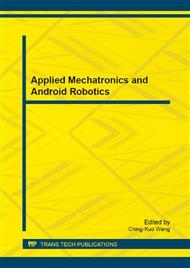[1]
M. Inaba, F. Kanehiro, S. Kagami, and H. Inoue, Two-armed bipedal robot that can walk, roll over and stand up, Intelligent Robots and Systems, vol. 3, (1995), p.297–302.
DOI: 10.1109/iros.1995.525899
Google Scholar
[2]
Jr-Syu Yang, Yu-Seng Chang, Standing Control of a Four-Link Robot, IEEE International Conference on Systems, Man and Cybernetics, vol. 1, (2005), p.679–684.
DOI: 10.1109/icsmc.2005.1571225
Google Scholar
[3]
Takuro Hatsukari, Shiho Kuroko and Norihisa Miyake, Self-help Standing-up Method Based on Quasi-static Motion, IEEE International Conference on Robotics and Biomimetics, (2009), p.342–347.
DOI: 10.1109/robio.2009.4913027
Google Scholar
[4]
K. Erbatur, A. Okazaki, K. Obiya, T. Takahashi, and A. Kawamura, A study on the zero moment point measurement for biped walking robots, International Workshop on Advanced Motion Control, (2002), p.431–436.
DOI: 10.1109/amc.2002.1026959
Google Scholar
[5]
J. H. Kim, and J. H. Oh, Walking control of the humanoid platform KHR-1 based on torque feedback control, IEEE International conference on Robotics and Automation, vol. 1, (2004), p.623–628.
DOI: 10.1109/robot.2004.1307218
Google Scholar
[6]
Qiang Huang, Kazuhito Yokoi, Planning Walking Patterns for a Biped Robot, IEEE Transactions on Robotics and Automation, vol. 17, no. 3, (2001), p.280–289.
DOI: 10.1109/70.938385
Google Scholar
[7]
Seungsu Kim, ChangHwan Kim, Bumjae You and Sangrok Oh, Stable Whole-body Motion Generation for Humanoid robots to Imitate Human Motions, IEEE/RSJ International Conference on Intelligent Robots and Systems, (2009), p.2518–2524.
DOI: 10.1109/iros.2009.5354271
Google Scholar
[8]
Li-Po Chou, Design and Implementation of An Intelligent Biped Robot with Motion Imitation Ability, Department of Electrical Engineering, College of Electrical Engineering and Computer Science, National Central University, Master Thesis, (2007).
Google Scholar
[9]
Jui-Yung Wu, The design and realization of interactive biped robots(II)basic motions control of biped robots, Department of Electrical Engineering, College of Electrical Engineering and Computer Science, National Central University, Master Thesis, (2008).
Google Scholar
[10]
Feng-Ching Liao, Standing control of a three-link robot, Department of Electrical Engineering, College of Electrical Engineering and Computer Science, National Central University, Master Thesis, (2003).
Google Scholar
[11]
Jung-Ting Jan, Walking Pattern Planning and Control of a Small-Size Humanoid Robot, Department of Electrical Engineering, College of Electrical Engineering and Computer Science, National Taiwan University of Science and Technology, Master Thesis, (2006).
Google Scholar


